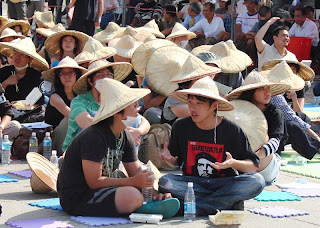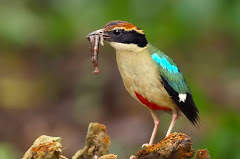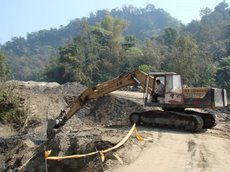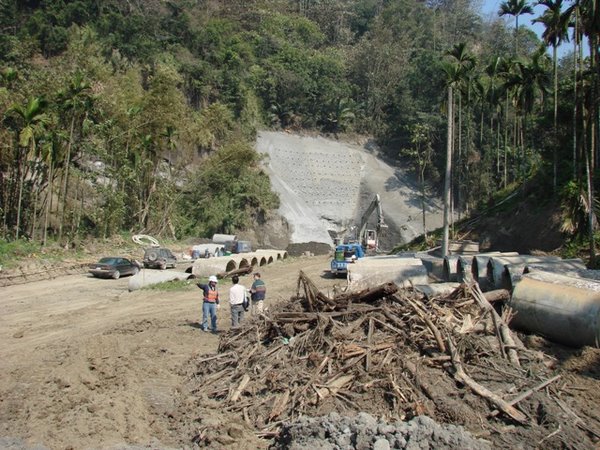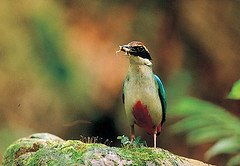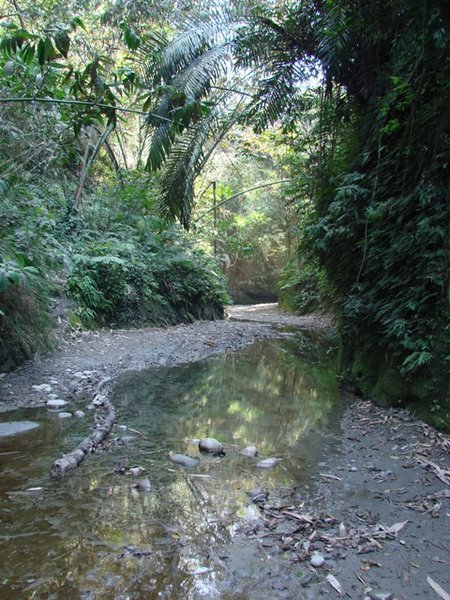The Malayan Night Heron Gorsachius melanolophus is a Huben-Hushan Important Bird Area (IBA) resident species. Taiwan has both resident and migrant populations of Malayan Night Heron. The Huben-Hushan IBA is one of the most reliable sites to see this species. They are very common in summer when migrants increase the resident population. In winter one can generally sight the species along quiet forest tracks. The Malayan Night Heron is listed in lower risk categories of the IUCN's Red Data list of threatened species. 
See: Huben-Hushan IBA Bird List
Photo is courtesy and copyright of Mark Wilkie.
Sunday, November 30, 2008
Malayan Night Heron
Posted by
Wild at Heart Legal Defense Association
at
9:05 PM
0
comments
![]()
Saturday, November 29, 2008
Moltrecht’s Tree Frog
The dazzling green endemic Moltrecht’s Tree Frog Rhacophorus moltrechti is one of the Huben-Hushan Important Bird Area's (IBA) resident frog species. Being endemic it is found nowhere else in the world but Taiwan. The species has a fairly high density in the area and can be found around most ponds within the forest. The Moltrecht’s Tree Frog is listed in lower risk categories of the IUCN's Red Data list of threatened species and is another reason why the Huben-Hushan IBA needs to be protected and preserved. 
Hushan Frog List
Photo is courtesy and copyright of Mark Wilkie.
Posted by
Wild at Heart Legal Defense Association
at
8:51 PM
0
comments
![]()
New Butterfly Photos Added to the Huben-Hushan Butterfly Gallery
Common Rose Pachliopta aristolochiae interposita (70-90mm).
Photos of three new species and several other butterfly photos have been added to the Huben-Hushan Butterfly Gallery.
See: Huben-Hushan Butterfly Gallery.
Posted by
Wild at Heart Legal Defense Association
at
8:29 PM
0
comments
![]()
Thursday, November 27, 2008
Formosan Macaques in the Huben-Hushan IBA
The Formosan Macaque Macaca cyclopis or Taiwan Rock Monkey as it is sometimes called is one of the mammal residents of the Huben-Hushan area. The Formosa Macaque, like the Fairy Pitta, is listed on the IUCN Red List as vulnerable. The macaques are not liked by farmers who tend to view them as fruit thieves. The macaques are heavily persecuted despite their protected status and are thus very shy and wary of people. A few recent photos of these shy Huben residents follows:
Posted by
Wild at Heart Legal Defense Association
at
3:38 PM
0
comments
![]()
Suppress democracy and freedom of expression and get a promotion: Police Chief gets promoted

While we are somewhat getting away from the subject of the Hushan Dam issue here. We hope that our readers can appreciate the concern we have at this point at the current attitude of the state towards protest. We are, after all, a blog protesting against the construction of the Hushan Dam and the destruction of the Huben-Hushan Important Bird Area (IBA).
Suppress democracy and freedom of expression and get a promotion. Well, Beitou Precinct Chief Lee Han-ching, the chief at the notorious Sunrise Records store incident on November 4th during the protests against Association for Relations Across the Taiwan Strait Chairman Chen Yunlin has been promoted.
First, Agency Director-General Wang Cho-chun told reporters on November 18 that Lee's handling of the Sunrise Records store incident was appropriate, then, later, he reprimands him. Now they've promoted Lee.
Democratic Progressive Party (DPP) Taipei City Councilors have released 53 photos of police allegedly using force against protesters during demonstrations earlier this month. The Paris-based International Federation for Human Rights has expressed concern over what it calls "grave violations of human rights" committed by police during the protests. As environmentalists we are frequently involved in protest. Recent events have sparked fear as the government continues to suppress freedom of speech and other civil liberties. The time may well be coming when the Taiwan environmental movement once again has to operate underground as it did during Taiwan's White Terror period.
See: What's in store for environmentalists in Taiwan's new Police State ?
We chatted to an expat law enforcement veteran and criminal sciences graduate who has witnessed violent protest on several occasions abroad. Under the present circumstances it is best if this person remains anonymous. Here are some comments from this person:
During the early November demonstrations in Taipei the protesters were pretty well behaved as far as protests go. Yes, there was some throwing of plastic bottles and similar objects, shouting, scuffles, occasional overturning or flattening of police barricades and such like. But there was not rampant mob violence by armed protesters, petrol bombings, Molotov cocktails, rampant destruction of property, looting, and the over-turning of cars that is all too common in protests seen around the globe today.
One just had to look at the clothing and equipment worn by many police officers to gauge what the real threat of the protesters to the police was. While some police officers were dressed in full riot gear of parts thereof, many, many police officers were dressed in their everyday standard issue police uniform and confronted protesters with nothing more than a big bamboo stick or baton. If the protesters really were a danger to the police I doubt these officers would have been dressed in this manner.
The general tactics of the police in confronting protesters was poor. The police presence was a huge show of power and obviously meant to intimidate. Often, TV footage showed motley groups of police officers dressed in standard everyday uniform to riot gear loosely engaging protesters. A very dangerous move if confronting a dangerous mob. If the crowd was a real angry and dangerous mob many of these groups of police officers would have been isolated and surrounded by the mob in no time and been seriously injured or killed. Officers would have had to fire their weapons to escape the mob. Such tactics doesn't say much for the competence of those in charge.
With Taiwan's authoritarian past and almost four decades of martial law, the police force in Taiwan was largely used to enforce the will of the state. They were the upholders of iron discipline rather than officers of the peace. As most of Taiwan's senior officers served much of their career's as the enforcers of a one party state it begs the question, "Do these men actually understand and believe in the real role of the police as agents of peace and lawfullness within the community?" The same question could be put to the men and women in the ranks. Do they really understand the role of the police?
Take a walk or ride around most Taiwan towns or villages and you will see police officers. Look at the vendors spilling out into the road. Look for obvious dangerous situations where construction, parked motor vehicles, and other hazards pose a serious risk to members of the community. What have the police, the officers of the peace and guardians of society, done about the situation? In most instances they just ride on by day in and day out.
The police force in Taiwan is well equipped. Taiwan also doesn't have a major crime problem. If we consider the high number of university graduates in the force it must be one of the most academically educated forces on the planet. Yet, looking at the villages and towns these officers "protect" we see huge safety problems. This shows that from the top down there seems to be little understanding of what they should be doing as officers of the peace.
Also see: Chinese or nothing ! The Fairy Pitta Protected Area letter response
Posted by
Wild at Heart Legal Defense Association
at
1:17 PM
0
comments
![]()
Wednesday, November 26, 2008
The Blue Percher Dragonfly
The Blue Percher Diplacodes trivialis is a beautiful dragonfly that can be seen year-round in the Huben-Hushan area. Click on photo to enlarge.

Photos are courtesy and copyright of Mark Wilkie.
Posted by
Wild at Heart Legal Defense Association
at
1:32 PM
0
comments
![]()
Tuesday, November 25, 2008
Chinese or nothing ! The Fairy Pitta Protected Area letter response
On October 27th supporters in the UK e-mailed an English letter voicing their concerns over a proposed Fairy Pitta Protected Area to Dr. Chen Wu-Hsiung, Minister of the Council of Agriculture. A copy of the letter was also sent to the Forestry Bureau and Wild at Heart Legal Defense Association, secretariat for the Taiwan National Coalition Against the Hushan Dam.
To date the office of the minister has not replied to the letter. The Forestry Bureau replied on November 7th. The reply was in Chinese. Our UK supporters can't read or write Chinese so they responded to the Forestry Bureau asking what the e-mail was about and also contacted us in Taiwan. To date the Forestry Bureau has not replied to the second e-mail.
Against the backdrop of the recent suppression of freedom of speech and democracy by the new Chinese National Party (KMT) Government the Chinese language response to an English letter is worth noting.
Government department websites are bilingual, Chinese and English. English is regarded as the foreign language of choice and is taught as the prescribed foreign language in Taiwanese schools. All students learn English from the third grade of elementary school through to the end of senior high school. Public officers must have a basic command of the English language as a job requirement.
For three years we have monitored international petitions and letters over the Hushan Dam Project sent to the government and the government has always responded in English. Overall, we have to say that the government has been pretty good about responding to English letters. That doesn't mean that we agree with what they say. The government seemed quite prepared to engage foreigners in English. For most of that time the Democratic Progressive Party (DPP) was in power.
The new KMT Government doesn't seem to share the same values. The new government has been very eager to please China and "re-sinogize" Taiwan. Names like the Taiwan Postal Service have been changed to the Chinese Postal Service. Even the allegedly "non-political NGO" the Wild Bird Federation of Taiwan [the BirdLife International partner for Taiwan] has jumped on the bandwagon and become the Chinese Wild Bird Federation. Peacefully protesting citizens have been arrested and beaten for waving the national flag.
As the new regime seems to be bending over backwards in an all out effort to erode Taiwan's democracy, sovereignty, and civil liberties in order to please China, it may seem that Mandarin Chinese is the only language the Taiwan Government wants to engage the world in.
Also see:
What's in store for environmentalists in Taiwan's new Police State ?
Concerns over reforesting projects in the Huben-Hushan area
Posted by
Wild at Heart Legal Defense Association
at
4:06 PM
0
comments
![]()
Monday, November 24, 2008
What's in store for environmentalists in Taiwan's new Police State ?


Recent events in Taiwan have shown that newly-elected President Ma Ying-jeou's Government has little respect for or understanding of freedom of speech, democracy, the right to protest, and human rights. Police have brutally attacked reporters and democracy protesters, and taken opposition leaders into custody without charging them. As Ma's regime tightens the screws on freedom of speech and suppresses democracy protests what kind of treatment can environmental activists expect when they voice their concerns to the Ma-led government ?
The visit by a sixty-strong Chinese delegation headed by Association for Relations Across the Taiwan Strait (ARATS) Chairman Chen Yun-lin earlier this month saw much of Taipei turning into a literal mini police state. It would appear that the Chinese Nationalist Party (KMT) Government was prepared to wind the clock back to the days of Martial Law* in a bid to impress their Chinese guests.
Police officers behaved in a manner reminiscent of the Martial Law era. Apart from behaving like baton-wielding-thugs they even rounded up people for waving the national flag. The Paris-based International Federation for Human Rights has expressed concern over what it calls "grave violations of human rights" committed by police during the protests.
With over a thousand Chinese missiles pointed at Taiwan and the constant threat of a Chinese invasion of Taiwan coupled with the way China constantly humiliates Taiwan in the international arena it is understandable that many Taiwanese have a distrust of the Chinese and are opposed to visits by Chinese officials to Taiwan while China continues to sabre-rattle and denies Taiwan's very existence as a nation.
In late October, ARATS Vice Chairman Zhang Ming-qing had said during a visit to Taiwan, "There will never be war in the Strait if there is no Taiwan independence." This was seen as a threat and it angered many in Taiwan and sparked a confrontation between pro Taiwan supporters and Zhang.
On Sunday, the Taiwan Wild Strawberries Movement held a memorial service for human rights. The Taiwan Wild Strawberries Movement** is a student movement that sprang up in response to police brutality during the November protests against ARATS Chairman Chen Yunlin's visit to Taiwan. The students have been staging a sit-in since November 6th. Police removed the students from outside the Executive Yuan in Taipei on November 7th. The students reformed their protest outside the Taiwan Democracy Memorial Hall and are still there. Students are holding similar protests in other Taiwan cities.
Their protest statement is, firstly, that President Ma Ying-jeou and Premier Liu Chao-shiuan must publicly apologize to all citizens for what has happened. Secondly, the National Police Agency Director-General Wang Cho-chiun and National Security Bureau Director Tsai Chao-ming must step down. And thirdly, the Legislative Yuan must revise the Parade and Assembly Law, which currently restricts the rights of the people.
While all this has been going on the Ma-led Government has staged a massive crackdown on opposition Democratic Progressive Party (DPP) politicians and several have been detained.
The previous KMT regime (1945-2000) had little respect for Taiwan's environment and had an extremely poor record for environmental protection. The Environmental Protection Administration (EPA) was largely seen as merely a rubber stamp administration. To a point this continued during the DPP government's two terms (2000-2008), two examples being the controversial appointment of the seventh Environmental Impact Assessment (EIA) Committee of the EPA and the handling of the assault of former EPA EIA Committee commissioner and Wild at Heart Legal Defense Association director, Robin Winkler, at a meeting at the EPA offices. Against the backdrop of recent events it would seem likely that environmental activists can expect to face the same iron wrath of the government the moment they take to the streets to voice their concerns for the environment.
* Following the end of World War II in September 1945 the Japanese colony of Taiwan was occupied by Chinese Nationalists Forces of Chiang Kai-shek [Taiwan had become a Japanese colony in 1895. Taiwan had been ceded to Japan by the Treaty of Shimonoseki following the Sino-Japanese War of 1894-1895. The Qing Government of China had exercised some control over parts Taiwan since 1683 but had never controlled the whole island. Following the Treaty of Shimonoseki Taiwan declared independence as the Republic of Taiwan. The short-lived Republic of Taiwan was defeated within a few months following the landing of the Japanese Army on 29 May 1895.]. The poor conduct of KMT forces and officials on Taiwan led to tensions between the Chinese and the Taiwanese. On 28 February 1947 things came to a head at the infamous 228 Incident. The Chinese Nationalist Party (KMT) used this as an excuse to rid Taiwan of its own leadership and intelligentsia by systematically murdering them in a brutal crackdown. The KMT then declared Martial Law in 1949. In 1949 the KMT were defeated by Mao's Chinese Communist Party (CCP) in the Chinese Civil War and the KMT fled to Taiwan where they set up their Republic of China regime on Taiwan. The Martial Law period lasted until 1987. This was known as the White Terror. During the White Terror anyone thought to be challenging the regime was rounded up and imprisoned. Many were tortured and executed by the brutal KMT police state.
** The post martial law generation in Taiwan is known as the strawberry generation. Strawberries being soft and fragile. In 1990 the Wild Lily Student Movement sought direct elections of Taiwan's president and vice president and representatives, and it played a part in the bringing about of Taiwan's first ever democratic elections. The origins of the name Wild Strawberries Movement incorporates these elements.
Sign the Wild Strawberries Movement's Human Rights and Democracy petition.
Also see: Chinese or nothing ! The Fairy Pitta Protected Area letter response
Suppress democracy and freedom of expression and get a promotion: Police Chief gets promoted
Some photos of the Wild Strawberries Movement protest in Taipei:
Posted by
Wild at Heart Legal Defense Association
at
10:26 AM
0
comments
![]()
Friday, November 21, 2008
Huben-Hushan Butterflies
An early name for Taiwan was the Butterfly Kingdom. Taiwan has a tremendously high density of butterfly species with around 400 butterfly species having been recorded on Taiwan (The continent of Europe and adjacent North African coast has around 440 species). The Huben-Hushan area, while famous for birds, is also home to many butterfly species. The butterflies and other insects of the area have been little studied and have hardly, if at all, been considered in the so-called environmental impact assessments (EIAs) done in the area for the Hushan Dam Project.
While forest and other habitat is fast disappearing due to the construction of Hushan Dam and other so-called development projects, naturalist Mark Wilkie and researchers from the Taiwan Endemic Species Research Institute have been recording butterfly species within the area over the past three years. Wilkie says that a butterfly list for the Huben-Hushan area listing around 140 species will be released shortly.
From late March through to about the tenth of April great numbers of Crow Butterflies (Euploea spp) pass through the Huben area on their spectacular journey from southern Taiwan to northern Taiwan. This butterfly migration is amongst the world's most spectacular butterfly migrations. Clearly, butterflies are another reason why the remaining forest within the Huben-Hushan area needs to be protected.
What follows are several photos of butterfly species recorded in the Huben-Hushan area. All photos are courtesy and copyright of Mark Wilkie.
Papilionidae:
Musk Swallowtail Byasa impediens febanus (80-90mm).
Paris Peacock Papilio paris nakaharai (80-90mm).
Common Rose Pachliopta aristolochiae interposita (70-90mm).
Tailed Green Jay Graphium agamemnon (60-80mm).
Common Bluebottle Graphium sarpedon connectens (50-60mm).
Golden Birdwing Troides aeacus formosanus (110-130mm).
Great Mormon Papilio memnon heronus (100-120mm).
Pieridae:
Common Albatross Appias albina semperi (50-60mm).
Grass Yellow Eurema hecabe (35-45mm).
Indian Cabbage White Pieris canidia (45-50mm).
Small Cabbage White Pieris rapae crucivora (45-50mm).
Wandering Snowflake Leptosia nina niobe (40-45mm).
Formosan Brimstone Gonepteryx amintha formosana (55-65mm).
Nympalidae:
Common Jester Symbrenthia lilaea formosanus (40-50mm).
Himalayan Jester Symbrenthia hypselis scatinia (35-43mm).
Asian Comma Polygonia c-aureum lunulata (48-58mm).
Indian Red Admiral Vanessa indica (50-60mm).
Blue Admiral Kaniska canace drilon (58-65mm).
Common Mapwing Cyrestis thyodamas formosana (45-50mm).
Orange Tiger Danaus genutia (70-80mm).
Glassy Tiger Parantica aglea maghaba (60-80mm).
Ceylon Blue Glassy Tiger Ideopsis similis (75-85mm).
Blue Tiger Tirumala limniace (80-90mm).
Blue-banded King Crow Euploea eunice hobsoni (80-90mm).
Striped Blue Crow Euploea mulciber barsine (75-95mm).
Double-branded Black Crow Euploea sylvester swinhoei (70-80mm).
Lemon Pansy Junonia lemonias aenaria (50-55mm).
Orange Oakleaf Kallima inachis formosana (70-80mm).
Formosan Ypthima Ypthima formosana (45-50mm).
Taiwan Wave-eye Ypthima multistriata (35-40mm).
Common Five-ring Ypthima baldus zodina (30-35mm).
Great Egg-fly Hypolimnas bolina kezia (65-100mm).
Common Sailor Neptis hylas lulculenta (47-55mm).
Rustic Cupha erymanthis (55-60mm).
Yellow Coster Acraea issoria formosana (60-75mm).
Common Palmfly Elymnias hypermnestra hainana (55-65mm).
Dark-brand Bush Brown Mycalesis mineus (45-50mm).
Bamboo Tree Brown Lethe europa pavida (55-65mm).
Lycaenidae:
Chinese Saphire heliophorus ila matsumurae (30-34mm).
Metallic Cerulean Jamides alecto dromicus (28-40mm).
Dark Cerulean Jamides bochus formosanus (26-30mm).
Pale Grass Blue Zizeeria maha okinawana (21-27mm).
Common Hedge Blue Acytolepsis puspa myla (24-32mm).
Malayan Megisba malaya sikkima (25-30mm).
Hesperiidae:
Restricted Demon Notocrypta curvifascia (40mm).
Formosan Swift Borbo cinnara (30-36mm).
Yellow Band Dart Potanthus pava (25-30mm).
Dark Palm Dart Telicota ohara formosanus (28-32mm).
Indian Palm Bob Suastus gremius (32-35mm).
Posted by
Wild at Heart Legal Defense Association
at
2:25 PM
6
comments
![]()











